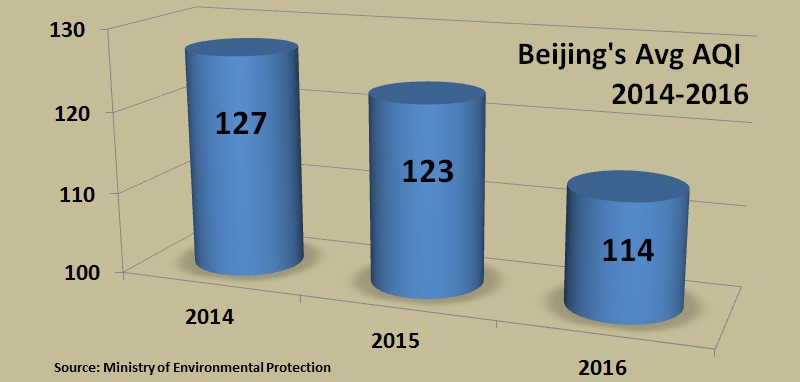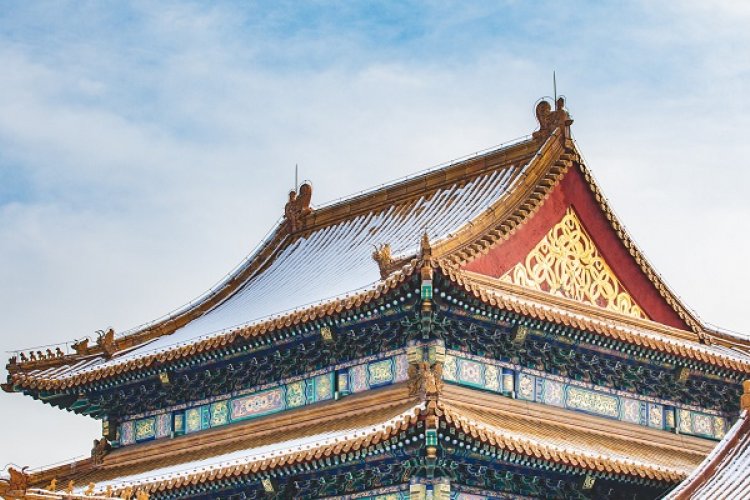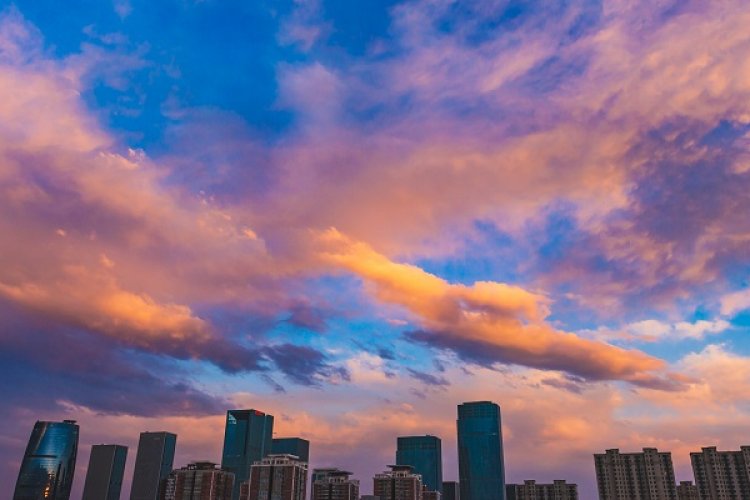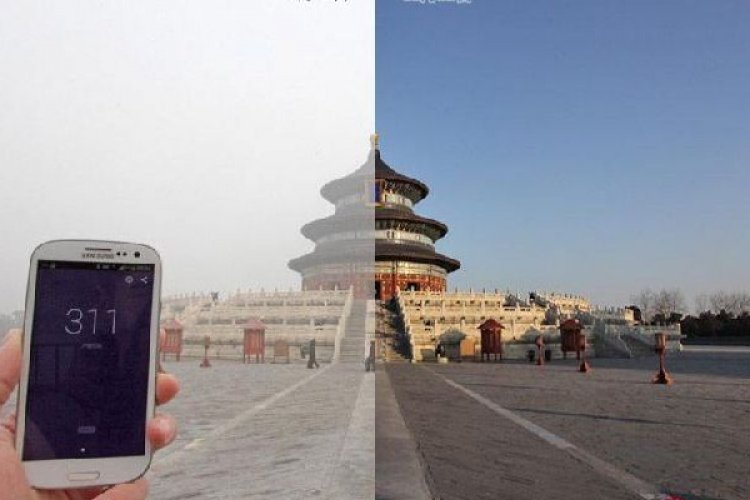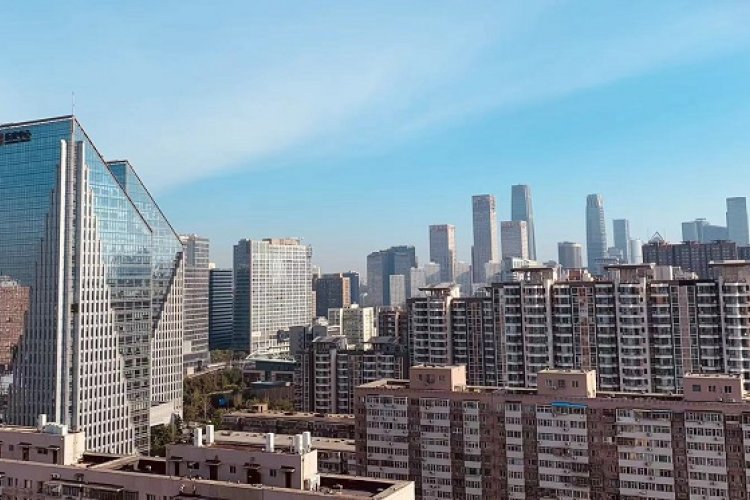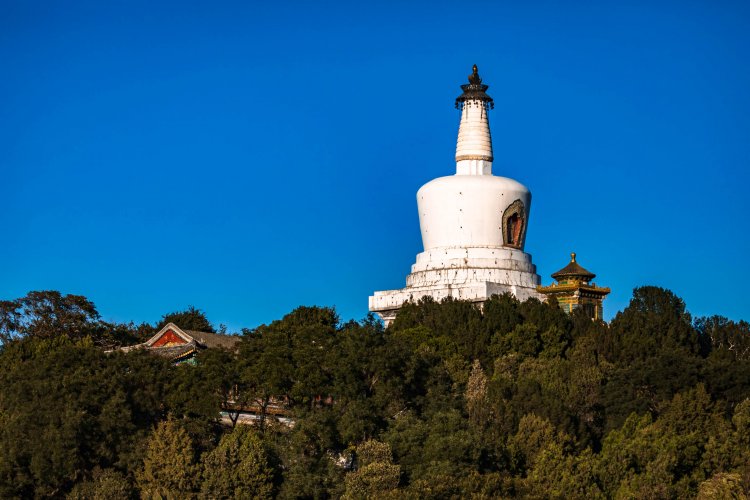Believe It or Not: Beijing's Air Was Better Overall in 2016
It may seem hard to believe given we're in the midst of an ugly stretch of some of the worst air in recent memory, but Beijing’s air in 2016 was 8 percent better than in 2015, according to statistics from the Ministry of Environmental Protection.
Of course there are many ways of quantifying bad air – you could talk PM 2.5 concentration, you could measure the total number of acceptable air days, or you could use average AQI readings: I like to use average AQI only because (a) I am lazy and this data is readily available; and (b) AQI is a catch-all rating for air quality that takes into consideration most of the important factors associated with bad air: particulate matter in both 2.5 micron and 10 micron sizes; ozone; nitrogen dioxide; carbon monoxide; and sulphur dioxide.
A brief primer for the uninitiated: the number in an AQI scale does not represent the count of anything specific; it’s a scale used as an easy-to-remember guideline percolated out of a wide array of data. We here in Beijing tend to obsess about PM 2.5; however, you could have a day with virtually no PM 2.5 floating around and still have a bad air day due to some other contaminant.
In practical terms, the biggest bugbear for Beijing is indeed PM 2.5, which was the primary pollutant on roughly 51% of the days of the past three years. Meanwhile, ozone was the primary pollutant on 28% of the days, Nitrogen Dioxide on 11% of the days, and PM 10 on 10% of the days.
The MEP has been releasing daily figures now since January 1, 2014, which gives us three years of comparative data to work with.

The good news: the average AQI reading for 2016 was 114, roughly an 8 percent improvement over 2015’s average AQI of 123, which itself was an improvement over 2014’s 127.
The bad news: extrapolating that gradual improvement over time – and assuming a continuous trend downward -- shows that it’ll be another decade before we’ll be averaging under AQI 50, the standard for great quality air. Here's to 2027!
Of course saying the air will be "good" cries out for a qualification of what exactly "good" means: China’s idea of AQI 50 and the US EPA's criteria are quite different:

As you can see from the chart above, China's standards for good air in terms of PM 2.5 concentration are far more lax than the US; a concentration of 35 micrograms per cubic meter would earn you an Excellent air rating in China (AQI 50), while an almost equal number would be closer to Moderate air quality (AQI 100) in the US. Interestingly, the standards for PM 10 are actually slightly stricter in China vs the United States.
Looking at the PM 2.5 picture specifically, Beijing made even greater strides: According to the Beijing News, the MEP is reporting an average PM 2.5 concentration of 73 micrograms per square meter for 2016, 9.9 percent lower than last year, and an even bigger jump than 2015's improvement over 2014.
Somewhat coincidentally, the 73 micrograms per square meter was exactly the target the govermnent forecasted they'd hit for 2017 as a whole -- which means they're one year ahead of schedule.
Some other factoids from the 2014-2016 data:
-- December has been the cruelest month (AQI 147), followed by March (133) and November (132).
-- The best months have been September (AQI 90), followed by August (105) and May (108)
-- There isn't much variation in air quality based on the day of the week, though Saturday is easily the worst day (8 percent worse than average, at AQI 132) and Monday is the best (5 percent better than average, at 116). Friday and Sunday were the second and third suckiest days of the week (though not by much)
-- The absolute worst month over the past three years was December 2015 (AQI 187), while the best was February 2016 (AQI 71).
-- And though we all firmly believe the air is worst in the winter, some of you might be surprised to see the average AQI by month, ranked by how bad the air has been over the past three years:
1. December (AQI 147)
2. March (AQI 133)
3. November (AQI 132)
4. July (AQI 128)
5. October (AQI 127)
6. February (AQI 123)
7. January (AQI 120)
8. June (AQI 118)
9. April (AQI 111)
10. May (AQI 108)
11. August (AQI 105)
12. September (AQI 90)
Related stories :
Comments
New comments are displayed first.Comments
![]() britomart
Submitted by Guest on Wed, 01/04/2017 - 11:07 Permalink
britomart
Submitted by Guest on Wed, 01/04/2017 - 11:07 Permalink
Re: Believe it or Not: Beijing's Air Was Better Overall in 2016
The only thing you can count on is not that the air will be better in 20 years, but that 40 million more Chinese will be dead, just from breathing it. Honesty is something valueable which chinese bosses and officials are seemingly yet to learn. I hope it comes to them soon, before they are all dead from chasig faster money as they deliver their China Global Toxo~Holocaust.
There IS an over-population problem here... Perhaps this is all part of the ongoing Grand Social Experiment that's been happening in this country for the last few decades.
![]() admin
Submitted by Guest on Tue, 01/03/2017 - 20:42 Permalink
admin
Submitted by Guest on Tue, 01/03/2017 - 20:42 Permalink
Re: Believe it or Not: Beijing's Air Was Better Overall in 2016
Well, let me address your points bit by bit.
2015 and 2016 were windier in coastal regions than usual
Can you point me in the direction of that data? PS Beijing is not a coastal region.
environment Departments have already been caught red handed manipulating the data.
Outside of Beijing, yes. If they are doing it in Beijing, (a) they have not been caught yet and (b) they are manipulating the US embassy readings as well, as their readings are generally in line with these.
Any day of the year Beijing is normally way above 200 let alone anything below 109, as can be witnessed in many independent readings on apps and internet data fed from monitoring stations all over the city.
show me your data for this. I believe you are mistaking one-time readings vs 24-hour averages; the historical data we are looking at and which is the standard used by both China and the US is 24-hour exposure. So for instance, today might peak at over 300 but it doesn't mean that the average over the 24-hour period is necessarily 300.
It is completely false both any claim that BJ air is better than previous years
Actually, the data indicates that this is the case. Perhaps you can site data that indicates otherwise.
or that it will meaningfully improve in the next ten years as 260 more toxic coal billowing power stations are going up in china
that very well may be the case. I am only looking at historical trends. While I am sure energy and coal use is likely to skyrocket, there are some hopeful signs on the horizon: More investment in alternative energy could offset this growth in coal; car emissions standards are gradually being tightened; the city is still only entering its 3rd year of any pollution warning system; more and more wealthy people and entreprenuers are waking up to this reality and attempting more so than ever before to counter it.
I hope that is the case. I'm on the pessimistic side as well.
Validate your mobile phone number to post comments.

